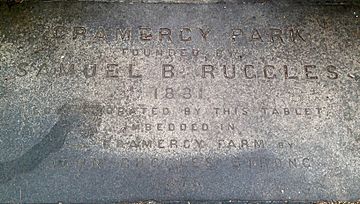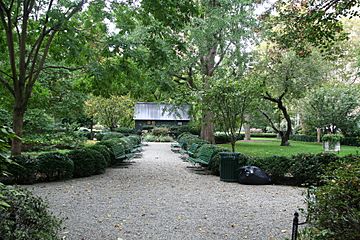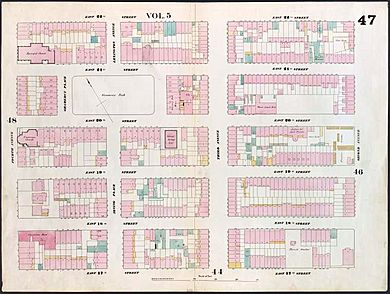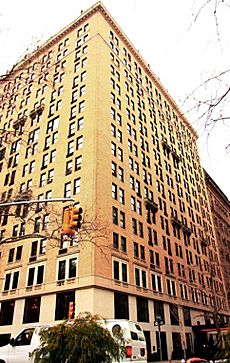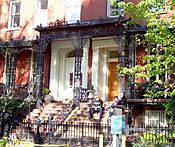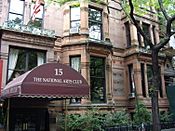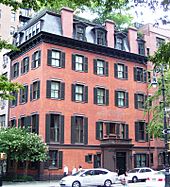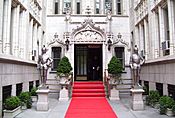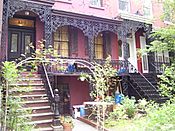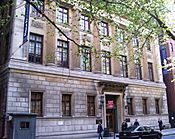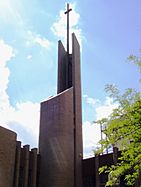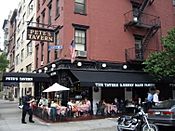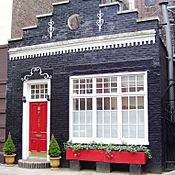Gramercy Park facts for kids
Quick facts for kids
Gramercy Park
|
|
|---|---|
|
Neighborhood and park
|
|
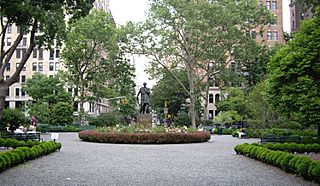
The view from the south gate of Gramercy Park, looking north from Gramercy Park South (East 20th Street), with the statue of Edwin Booth in the center. The Gramercy Park Hotel is visible in the left background. (May 2007)
|
|
| Country | |
| State | |
| City | New York City |
| Borough | Manhattan |
| Community District | Manhattan 5, Manhattan 6 |
| Population
(2010)
|
|
| • Total | 27,988 |
| Time zone | UTC−5 (Eastern) |
| • Summer (DST) | UTC−4 (EDT) |
| ZIP Codes |
10003, 10010
|
| Area code(s) | 212, 332, 646, and 917 |
|
Gramercy Park Historic District
|
|
 |
|
| Location | Manhattan, New York City Roughly bounded by:
|
| Architectural style | Greek Revival, Italianate, Gothic Revival |
| NRHP reference No. | 80002691 |
| Added to NRHP | January 23, 1980 |
Gramercy Park is the name of both a small, fenced-in private park, and the surrounding neighborhood that is also referred to as Gramercy, in Manhattan in New York City.
The approximately 2-acre (0.8 ha) park, located in the Gramercy Park Historic District, is one of two private parks in New York City – the other is Sunnyside Gardens Park in Queens – as well as one of only three in the state; only people residing around the park who pay an annual fee have a key, and the public is not generally allowed in – although the sidewalks of the streets around the park are a popular jogging, strolling, and dog-walking route.
The neighborhood is mostly located within Manhattan Community District 6, with a small portion in Community District 5. It is generally perceived to be a quiet and safe area.
The neighborhood, associated historic district, and park have generally received positive reviews. Calling it "a Victorian gentleman who has refused to die", Charlotte Devree in The New York Times said that "There is nothing else quite like Gramercy Park in the country." When the New York City Landmarks Preservation Commission created the Gramercy Park Historic District in 1966, they quoted from John B. Pine's 1921 book, The Story of Gramercy Park:
The laying out of Gramercy Park represents one of the earliest attempts in this country at 'City Planning'. ... As a park given to the prospective owners of the land surrounding it and held in trust for those who made their homes around it, Gramercy Park is unique in this City, and perhaps in this country, and represents the only neighborhood, with possibly one exception, which has remained comparatively unchanged for eighty years – the Park is one of the City's Landmarks.
Contents
Boundaries
Gramercy Park itself is located between East 20th Street (called Gramercy Park South at the park), and East 21st Street (called Gramercy Park North), and between Gramercy Park West and Gramercy Park East, two mid-block streets which lie between Park Avenue South and Third Avenue. Irving Place commences at the southern end of Gramercy Park, running to 14th Street, and Lexington Avenue, a major north-south thoroughfare on the East Side of Manhattan, terminates at the northern end.
The neighborhood's boundaries are 14th Street to the south, First Avenue to the east, 23rd Street to the north, and Park Avenue South to the west. Nearby are the Flatiron District to the west, Union Square to the southwest, the East Village to the south, Stuyvesant Town and Peter Cooper Village to the east, Rose Hill to the northwest, and Kips Bay to the northeast.
The boundaries of the Historic District, set in 1966 and extended in 1988, are irregular, lying within the neighborhood, and can be seen in the map in the provided infobox. A proposed extension to the district would include more than 40 additional buildings on Gramercy Park East and North, Lexington Avenue, Park Avenue South, East 22nd and East 19th Streets, and Irving Place.
Etymology
The area received its name as an anglicization of Crommessie, which is derived from the Dutch Krom Moerasje, meaning 'little crooked swamp', or Krom Mesje, meaning 'little crooked knife', describing the shape of the swamp, brook and hill on the site. The brook, which later became known as Crommessie Vly, flowed in a 40-foot gully along what is now 21st Street into the East River at 18th Street. Krom Moerasje/Krom Mesje became corrupted to Crommessie or Crommashie. Mayor James Duane – for whom the city's Duane Street is named – acquired the site in 1761 from Gerardus Stuyvesant and named it Gramercy Seat. Gramercy is an archaic English word meaning 'many thanks'.
History
Origin and development
The area which is now Gramercy Park was once in the middle of a swamp. In 1831 Samuel B. Ruggles, a developer and advocate of open space, proposed the idea for the park due to the northward growth of Manhattan. He bought the property, 22 acres of what was then a farm called "Gramercy Farm", from the heirs of James Duane, son of the former mayor, father of James Chatham Duane, and a descendant of Peter Stuyvesant. Ruggles then deeded the land on December 17, 1832 to five trustees, who pledge to hold 42 lots in trust to be used as parkland. To develop the property, Ruggles spent $180,000 to landscape it, draining the swamp and causing about a million horsecart loads of earth to be moved. He then laid out "Gramercy Square", deeding possession of the square to the owners of the 66 parcels of land he had plotted to surround it, and sought tax-exempt status for the park, which the city's Board of Aldermen granted in 1832. It was the second private square created in the city, after Hudson Square, also known as St. John's Park, which was laid out by the parish of Trinity Church. Numbering of the lots began at No. 1 on the northwest corner, on Gramercy Park West, and continued counter-clockwise: south down Gramercy Park West, then west to east along Gramercy Park South (East 20th Street), north up Gramercy Park East, and finally east to west along Gramercy Park North (East 21st Street).
As part of his overall plan for the square, Ruggles received permission on January 28, 1833 from the Board of Alderman to open up Fourth Avenue, which had been limited to use by trains, to vehicular traffic. He also brought about the creation by the state legislature of Lexington Avenue and Irving Place, two new north-south roads laid out between Third and Fourth Avenues and feeding into his development at the top and bottom of the park. The new streets reduced the number of lots around the park from 66 to 60.
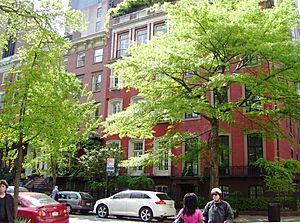
Gramercy Park was enclosed by a fence in 1833, but construction on the surrounding lots did not begin until the 1840s, due to the Panic of 1837. In one regard this was fortunate, since the opening of the Croton Aqueduct in 1842 allowed new townhouses to be constructed with indoor plumbing.
The first formal meeting of the park's trustees took place in 1844 at 17 Union Square (West), the mansion of James W. Gerard, which is no longer extant, having been demolished in 1938. By that time, landscaping had already begun with the hiring of James Virtue in 1838, who planted privet inside the fence as a border; by 1839 pathways had been laid out and trees and shrubs planted. Major planting also took place in 1844 – the same year the park's gates were first locked – followed by additional landscaping by Brinley & Holbrook in 1916. These plantings had the effect of softening the parks' prim formal design.
Later 19th century events
In 1863, in an unprecedented gesture, Gramercy Park was opened to Union soldiers involved in putting down the violent Draft riots which broke out in New York, after conscription was introduced for the Civil War. Gramercy Park itself had been protected with howitzers by troops from the Eighth Regiment Artillery, while the 152nd New York Volunteers encamped in nearby Stuyvesant Square.
At No. 34 and No. 36 Gramercy Park (East) are two of New York's first apartment buildings, designed in 1883 and 1905. In addition, No. 34 is the oldest existing co-operative apartment building in the city. Elsewhere in the neighborhood, nineteenth century brownstones and carriage houses abound, though the 1920s brought the onset of tenant apartments and skyscrapers to the area.

In 1890 an attempt was made to run a cable car through the park to connect Irving Place to Lexington Avenue. The bill passed the New York State Legislature, but was vetoed by Governor David B. Hill. Twenty-two years later, in 1912, another proposal would have connected Irving Place and Lexington Avenue, bisecting the park, but was defeated through the efforts of the Gramercy Park Association, now called Gramercy Neighborhood Associates.
In the late 19th century, numerous charitable institutions influential in setting social policy were located on 23rd Street, and some, such as the Federation of Protestant Welfare Agencies, still remain in the area. Calvary Church on Gramercy Park North has a food pantry that opens its doors once a week for one hour, and the Brotherhood Synagogue on Gramercy Park South served as an Underground Railroad station before the Civil War, when the building was a Quaker meeting house, established in 1859.
20th and 21st centuries
The Hotel Irving, at 26 Gramercy Park South, was constructed c.1903. Among its guests was a young Preston Sturges, who stayed there in 1914 while his mother lived with Isadora Duncan at the Ritz-Carlton Hotel. A townhouse on the north side of the Park was provided for Duncan's dancing school, and their studio was nearby on the northeast corner of Park Avenue South (then Fourth Avenue) and 23rd Street. The Hotel Irving was converted to a co-op in 1986.
In the center of the park is a statue of one of the area's most famous residents, Edwin Booth, which was dedicated on November 13, 1918. Booth was one of the great Shakespearean actors of 19th Century America, as well as the brother of John Wilkes Booth, the assassin of Abraham Lincoln. The mansion at No. 16 Gramercy Park (South) was purchased by Booth and renovated by Stanford White at his request to be the home of the Players' Club, which Booth founded. He turned over the deed to the building on New Year's Eve 1888. Next door at No. 15 Gramercy Park (South) is the National Arts Club, established in 1884 in a Victorian Gothic mansion which was originally home to the New York Governor and 1876 Presidential Candidate, Samuel J. Tilden. Tilden had steel doors and an escape tunnel to East 19th Street to protect himself from the sometimes violent politics of the day.
On September 20, 1966, a part of the Gramercy Park neighborhood was designated an historic district, the boundaries of which were extended on July 12, 1988. The district was listed on the National Register of Historic Places in 1980. A proposed extension of the district would include nearby buildings such as the Manhattan Trade School for Girls, now the School of the Future, and the Children's Court and Family Court buildings, now part of Baruch College, all on East 22nd Street.
In 1983, Fantasy Fountain, a 4.5 stone (63 lb; 29 kg) bronze sculpture by Greg Wyatt was installed in the park.
One of the most significant steam explosions in New York City occurred near Gramercy Park in 1989, killing two Consolidated Edison workers and one bystander, and causing damage of several million dollars to area buildings.
In 2012, 18 Gramercy Park South – formerly the Salvation Army's Parkside Evangeline Residence for Women and then a facility of the School of Visual Arts – was sold to Eyal Ofer's Global Holdings and the Zeckendorf brothers for $60 million for conversion into condominium apartments by Robert A. M. Stern, including a $42 million penthouse duplex. The 17-story building is the tallest around the park and dates from 1927.
Ownership and access to the park
Since December 31, 1831, Gramercy Park has been held in common by the owners of the 39 surrounding structures. Two keys are allocated to each of the original lots surrounding the park, and the owners may buy keys for a fee, which was originally $10 per key, but as of 2008[update] was $350, with a $1,000 fee for lost keys, which rises to $2,000 for a second instance. The Medeco locks are changed annually, and any property that does not pay the annual assessment of $7,500 per lot has its key privileges revoked; additionally, the keys are very hard to duplicate. As of 2012[update], there were 383 keys in circulation, each individually numbered and coded.
Members of Players Club and the National Arts Club as well as guests of the Gramercy Park Hotel, which has 12 keys, have access, as does Calvary Church and the Brotherhood Synagogue; hotel guests are escorted to the park and picked up later by hotel staff. In addition, the owners of the luxury condominium apartments at 57 Irving Place, completed in 2012, can obtain key access to the park by becoming members of the Players Club, even though the building is located several blocks from the park.
At one time, the park was open to the public on an annual Gramercy Day whose date changed each year but was often the first Saturday in May. In 2007, the trustees announced that the park would no longer be open for Gramercy Day because it "had turned into a street fair". The park, however, continues to be open to the public on Christmas Eve. Visitors to the park may not drink alcohol, smoke, ride a bicycle, walk a dog, play ball or Frisbee, or feed the birds and squirrels.
Demographics
Based on data from the 2010 United States Census, the population of Gramercy Park was 27,988, an increase of 1,804 (6.9%) from the 26,184 counted in 2000. Covering an area of 171.71 acres (69.49 ha), the neighborhood had a population density of 163.0 inhabitants per acre (104,300/sq mi; 40,300/km2). The racial makeup of the neighborhood was 73.7% (20,623) White, 3.3% (923) African American, 0.1% (19) Native American, 13.4% (3,740) Asian, 0.0% (10) Pacific Islander, 0.3% (77) from other races, and 2.0% (573) from two or more races. Hispanic or Latino of any race were 7.2% (2,023) of the population.
Surrounding neighborhood
The neighborhood, which is called either "Gramercy Park" or "Gramercy", is generally considered to be a quiet and safe area. While real estate in Manhattan is rarely stable, the apartments in the neighborhood around Gramercy Park have experienced little turmoil. East 19th Street between Third Avenue and Irving has been called "Block Beautiful" for its wide array of architecture and pristine aesthetic. Townhouses with generous backyards and smaller apartments alike coincide in a collage of architecture in Gramercy Park. The largest private house in the neighborhood, a 42-room mansion on Gramercy Park South, was on sale for $7 million in 1993.
The Gramercy Park neighborhood is located in the part of Manhattan where the bedrock Manhattan schist is located deeper underground than it is above 29th Street and below Canal Street, and as a result, and under the influence of zoning laws, the tallest buildings in the area top out at around 20 stories, and older buildings of 3–6 floors are numerous, especially on the side streets, but even on the avenues.
The quiet streets perpendicular to Irving Place have maintained their status as fashionable residential blocks reminiscent of London's West End. In 1912, a multiple dwelling planned specifically for bachelors appeared at 52 Irving Place. A Colonial Revival style structure with suites of rooms that lacked kitchen facilities was one of a small group of New York apartment houses planned for single men in the early years of the 20th century.
Gramercy Park Hotel
Gramercy Park Hotel was originally designed by Robert T. Lyons and built by Bing & Bing in 1925, replacing a row of townhouses. It was managed for many years by hotelier Herbert Weissberg, and in 2006 underwent a massive makeover by Ian Schrager, who in 2010 sold his interests and is no longer associated with the hotel. Interiors were designed by artist and filmmaker Julian Schnabel. The Hotel has views of Gramercy Park, and guests have access to the hotel's 12 keys to the park during their stay. Dining venues include the Rose Bar and Jade Bar, and rooftop Gramercy Terrace restaurant; Danny Meyer's Maialino is also in the Hotel.
The Hotel was the subject of a 2008 documentary film, Hotel Gramercy Park.
Irving Place
An assortment of restaurants, bars, and establishments line Irving Place, the main thoroughfare of the neighborhood south of the park. Pete's Tavern, New York's oldest surviving saloon, and where O. Henry is often erroneously said to have written The Gift of the Magi, survived Prohibition disguised as a flower shop. Irving Plaza, at East 15th Street and Irving, hosts numerous concerts for both well-known and indie bands and draws a crowd almost every night. There are also a number of clinics and official city buildings on Irving Place.
Education
Schools
Two public high schools are located in the area: Washington Irving High School on Irving Place, and the School of the Future on 22nd Street at Lexington Avenue, which is also a middle school.
P.S. 40, the Augustus Saint-Gaudens School, serving grades Pre-K to 5, is the only general public elementary school in the neighborhood; it is located on East 20th Street between First and Second Avenues, near the Augustus Saint-Gaudens Playground, Peter's Field, and the park at Stuyvesant Square. The building also houses a middle school named after Jonas Salk: the Salk School of Science, serving grades 6–8. M.S. 104 the Simon Baruch Middle School, which also serves grades 6–8, is located just east of, P.S. 40 and Salk, on the same block but across the street. Nearby, on East 23rd Street, is the American Sign Language and English School, a public elementary and middle school which provides American Sign Language immersion education for deaf and hearing children. The ASL and English School building also hosts other public school programs.
Also located in the neighborhood is The Epiphany School, a Catholic elementary school on 22nd Street at Second Avenue. Founded in 1885 for religious instruction in the parish of the Epiphany, the school has been a landmark – gutted and rebuilt – in the neighborhood for generations. At 20th Street and Second Avenue is a new building for the Learning Spring School, a private school for high-functioning autistic children funded by the Simons Foundation Autism Research Initiative. The building houses an elementary and middle school, grades K-8.
The École Internationale de New York, a French international school, is primarily located in the Gramercy Park neighborhood, partly at 111 East 22nd Street between Park and Lexington Avenues, where the 1st, 2nd and 3rd grades and the Middle School are sited; and partly in the "Renwick Gem" of Calvary Church at 277 Park Avenue, where the 4th and 5th grades are located. There is also a preschool at 206 Fifth Avenue between West 25th and 26th Streets in the NoMad neighborhood.
Higher education
The buildings of Baruch College of the City University of New York (CUNY) are located in the neighborhood or nearby. Baruch College's Lawrence and Eris Field Building is located at the southeast corner of Lexington Avenue and 23rd Street in Gramercy. The facilities of The School of Visual Arts are located on East 23rd Street and elsewhere. SVA students are housed in Gramercy Park Women's Residence, George Washington Hotel and the New Residence. In addition, New York University's Gramercy Green dormitory is located in Gramercy.

Library
The New York Public Library (NYPL)'s Epiphany branch is located at 228 East 23rd Street. The Epiphany branch opened in 1887 and moved to its current structure, a two-story Carnegie library, in 1907. It was renovated from 1982 to 1984.
Hospitals
Although Gramercy is not far from "hospital row" on First Avenue above 23rd Street, the primary medical center in its boundaries is Beth Israel Medical Center between East 15th and 17th Streets off of First Avenue. Nearby is the Hospital for Joint Diseases, part of the NYU Medical Center, and the New York Eye and Ear Infirmary on 14th Street. Cabrini Medical Center, on East 19th and 20th Streets, closed down in 2008, but the buildings were purchased by Memorial Sloan-Kettering Cancer Center in 2010, for use as a cancer outpatient facility.
Post office and ZIP Codes
Gramercy is located in two ZIP Codes. The area south of 20th Street is located in 10003, while the area north of 20th Street is located in 10010. The United States Postal Service operates the Madison Square Station post office at 149 East 23rd Street.
Notable residents
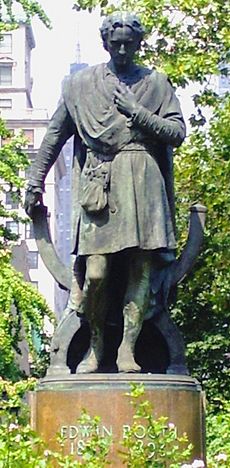
Around the park
- No. 1 – Amos Pinchot – brother of former Governor of Pennsylvania
- No. 1 – Valentine Mott – an original resident, chief medical officer of the Union Army and founder of Bellevue Hospital and NYU Medical School
- No. 2 – James W. Pinchot – businessman and father of Gifford Pinchot, who was the first chief of the U.S. Forest Service
- No. 3&4 – James Harper – an original resident, 1847–1869, Mayor of New York from 1844 to 1845 and one of the founders of the Harper publishing firm; the two iron lamps outside No. 4 were placed there by the city in Harper's honor: the custom was that mayor's residences were so distinguished so that he would be available for nighttime emergencies
- No. 5 – Vincent Astor – businessman, philanthropist, member of the Astor family
- No. 7 – Julia Roberts - American actress
- No. 10 – Henrietta B. Haines – novelist
- No. 11 – Robert Henri – American painter
- No. 11 – Samuel L. M. Barlow II – composer, patron of the arts
- No. 15 – Samuel J. Tilden – whose house, a National Historic Landmark, is now the National Arts Club
- No. 16 – Edwin Booth – famed Shakespearean actor, founded The Players
- No. 19 – Stuyvesant Fish – a leader of New York society (1887)
- No. 19 – Edward Sheldon – playwright
- No. 19 – William C. Bullitt – diplomat, journalist and novelist
- No. 19 – Benjamin Sonnenberg – publicist
- No. 19 - Richard Tyler - designer
- No. 19 - Henry Jarecki - entrepreneur
- No. 24 – Richard Watson Gilder – the poet and editor died in this house
- No. 24 – Thomas Alva Edison – inventor
- No. 24 – Albert Gallatin – Secretary of the Treasury
- No. 26 – Booth Tarkington – novelist and dramatist
- No. 26 – Steinway family – manufacturers of Steinway pianos
- No. 34 – James Cagney, Margaret Hamilton, and Gregory Peck,
- No. 36 – John Barrymore – star of stage and screen
- No. 36 – Daniel Chester French – sculptor responsible for the seated figure of Lincoln at the Lincoln Memorial in Washington, D.C.
- No. 36 – Alfred Ringling – founder of the Ringling Brothers Circus
- No. 38 – John Steinbeck – author
- No. 44 – Hart Crane – poet
- Where the Gramercy Park Hotel and the connected 50 Gramercy Park North co-op are now located:
- Stanford White – architect
- Robert G. Ingersoll – orator
- Elsewhere around the park:
- Frances Bavier – stage and television actress, Aunt Bee on The Andy Griffith Show
- John Bigelow – lawyer and statesman, who lived at 21 Gramercy Park
- Vincent D'Onofrio- actor, producer, director, and singer
- Jimmy Fallon – host of The Tonight Show Starring Jimmy Fallon
- Henry Herbert – English actor and producer
- Robert H. Ingersoll – businessman
- Karl Lagerfeld – fashion designer
- Maud Powell – female concert violinist and suffrage pioneer who cast her first ballot in 1919
- George Templeton Strong – lawyer and diarist, an original resident, who lived at 55 Gramercy Park North
- Uma Thurman – actress
- Rufus Wainwright – musician
Around the neighborhood
- John Avlon and Margaret Hoover, newscasters
- Peter Cooper – industrialist, entrepreneur and philanthropist, lived just north of the park at 9 Lexington Avenue.
- Joseph P. Day (1874–1944), real estate broker and developer and auctioneer
- Theodore Roosevelt's birthplace on 20th Street is a National Historic Site.
- Edith Wharton – author, born at 14 West 23rd Street and attended Calvary Church
- Oscar Wilde took rooms at 47 Irving Place for a while in 1882, some ten years before his future literary agent in America, Elisabeth Marbury set up home next door at 49 Irving Place with interior designer Elsie de Wolfe. De Wolfe and Marbury were said to be the most fashionable lesbian couple of Victorian New York.
- Chelsea Clinton, the daughter of U.S. President Bill Clinton and First Lady Hillary Clinton, as well as her husband Marc Mezvinsky, used to live in the neighborhood before moving to nearby NoMad, selling their apartment for $4 million.
Many actors, actresses and artists live in the district including Kate Hudson, Whitney Port, Joshua Bell, Jimmy Fallon and Amanda Lepore. Amanda Peet grew up in the neighborhood. Winona Ryder once resided in Gramercy Park, but sold her co-operative apartment in 2008. The fashion designer Narciso Rodriguez has his studio on Irving Place and the neighborhood is home to numerous models' apartments from nearby agencies on Broadway. NBC News anchor Ann Curry also lives in the neighborhood.
Gallery
- Around the Park
-
#3 & 4: Doorways of the Greek Revival townhouses, design attributed to Alexander Jackson Davis, "one of America's most versatile 19th century architects"
-
#15: The National Arts Club, former home of Samuel J. Tilden, remodeled for Tilden by Calvert Vaux
-
#19, built in 1845 and remodeled in 1887 for Stuyvesant Fish. John Barrymore lived here while working on Broadway.
-
#28: The Brotherhood Synagogue was a stop on the Underground Railroad when it was a Quaker meeting house The Travelers' Aid Society grew out of one of the congregation's activities.
- Around the neighborhood
-
Italianate townhouses on East 18th Street (1853), with cast-iron verandas reminiscent of the French Quarter of New Orleans.
-
Steeple of Epiphany Roman Catholic Church, "The most positive modernist religious statement on Manhattan Island to date."
-
Pete's Tavern, where urban legend has it that O. Henry wrote "The Gift of the Magi", was formerly the Portman Hotel.
See also
 In Spanish: Gramercy Park para niños
In Spanish: Gramercy Park para niños


